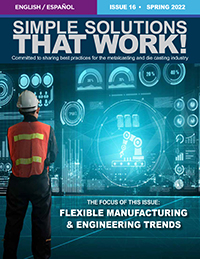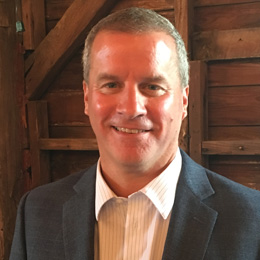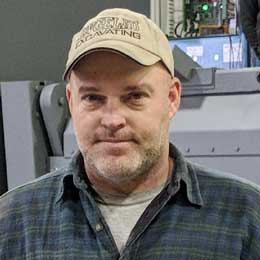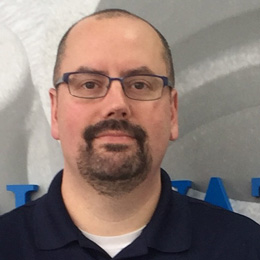Additive Manufacturing for Aerospace Components

CHRIS BECK Manager of Operations, Co-Owner INNOVATIVE 3D MANUFACTURING
Published April 2022, Simple Solutions That Work!™
Reprinted with permission from Simple Solutions That Work!™
ARTICLE TAKEAWAYS:
The hottest and trendiest topic in manufacturing today is Additive Manufacturing. Additive Manufacturing (AM) also known as 3D Printing can produce parts from plastic and metal. There are 3 common plastic processes and 5 common metal processes available today.
Our article will focus on DMLS (Direct Metal Laser Sintering) also known as SLM (Selective Laser Melting) and sometimes referred to as Powder Bed Fusion. This process lays out layers of powdered metal from 20 to 100 micron then melts the area of the part to the prior layer. It’s a truly amazing technology that creates parts that are 99.5% dense.
PARTS FOR AEROSPACE
There is a fair amount of skepticism regarding the quality and density of parts that are built by the DMLS process. Frankly, I was one of those guys too. When we first started researching the process and looking for capital equipment to purchase it was a true eye opener. Not only can you make near net complex shapes with internal passages but the parts are denser (on average 99.5%) than a casting. We looked at this as a win-win.
A few years ago, the first parts we machined were amazing. There was no visual porosity – the parts looked like they were machined from solid bar stock. For the aerospace market, this is a huge advantage. Now, we are able to print the most common aerospace alloys including Inconel 625 and 718, Cobalt Chrome, Aluminum and Titanium.
You are truly only limited by your design imagination and your check book. Innovative 3D always includes 2 vertical and 2 horizontal tensile test bars, a material test plug and loose powder sample for every certified part build. We are able to check composition, tensile strength, hardness, and microstructure in our inhouse materials lab.
MATERIALS
One of our powder vendors has atomized over 1000 different powders for the DMLS process. This sounds great to the customer but it does create a bit of an issue for the people running the equipment. For example if you are building a tall prototype part and want the part to be built from Haynes 282 material, it may cost around $20,000 to buy enough powder to fill the machine to make one part. Then a company has to develop a machine laser parameter set that work in order to achieve high density and good surface finish. Therefore, the one-off prototype may not make sense with that specific material type. If the customer is fine with using a similar material for the test like Inconel 718 then the prototype can be much more cost effective as Inconel 718 is a very popular AM powder. The takeaway on this, is that engineers need to be flexible with materials when developing working prototypes.
There are many considerations to determine which parts are best for the DMLS machines. First and foremost, remember that most DMLS machines are 10”x10”x12” LxWXH. After that, take into considering the size, weight, part geometry, surface finish and tolerance.
PART WEIGHT
Powder is very expensive, $30 to $130 per pound. The more the part weight the longer it takes to print which drives the price up. Material price is never the limiting factor—it’s always print time, which is how most service bureaus including Innovative 3D price their parts.

PART GEOMETRY & PART DESIGN
The AM process does not like “overhangs” on parts. This refers to a specific feature on a part hanging out in space with nothing underneath it to support it. Examples are boss or v-flanges that would be traditionally welded onto a part or built into a casting. These features need to have gussets or angles designed below them. They can be designed to be permanent or designed to be removed after the part is made.
SURFACE FINISH
Because the laser melts a straight line and the powder size varies; this can cause a rough surface finish. We like to tell our customers on average to expect a 250 Ra finish. With minimal work a Scotch Brite pad can bring this finish to 120 Ra. Most machined surfaces are 63 Ra or less. In the aerospace world this can be a problem because of air flow across turbine blades, veins, airfoils and swirlers. There are many post processing tricks to polish and get those surfaces to the desired finish.
TOLERANCING
Geometrical Dimensioning and Tolerancing (GD&T) seems to be a constant issue as this technology is only so accurate. Under normal conditions on a straight up and down feature the AM machine will hold .005” of diameter, length and true position. When the part is built at an angle the machine tolerance will open up to 2 or 3 times that it would be on a horizontal build and holes start to become oval shaped.
In many instances we make parts without holes or make them undersized so that we can machine them later to hold tighter hole tolerancing and true positions. The design team can make or break an AM project with GD&T.
DESIGN FOR ADDITIVE MANUFACTURING
We build many parts that are a traditional casting design. The problem with this is that the part has not been modified for the AM process. In other words, the part will have features like bosses and flanges hanging out in space with no support structure underneath them. To accommodate this design, we add a support structure or some type of gusset design to support the geometry to make it a selfsupported geometry.
COST AND DELIVERY
On average parts built by the DMLS process cost 2 to 4 times the price of a traditional investment casting. They will be as low as 25% the cost of traditional machining from solid billet stock. Deliveries average from 2 to 6 weeks including all post processing and machining. Parts that require X-ray, pressure test, and FPI may add additional time to delivery.
SUMMARY
Additive Manufacturing is here to stay. All of the large aerospace companies are adopting the technology. They are slow and cautious for flight approved hardware, but they are using it for R&D projects and other places that it makes sense for cost savings and deliveries. Machine work envelopes are getting larger and the development of multi-head lasering equipment is decreasing build time which makes it cost competitive. It’s not a technology that will take over mass production anytime soon but it can definitely make sense for low volume super alloy parts, prototypes, support tooling and fixturing.


